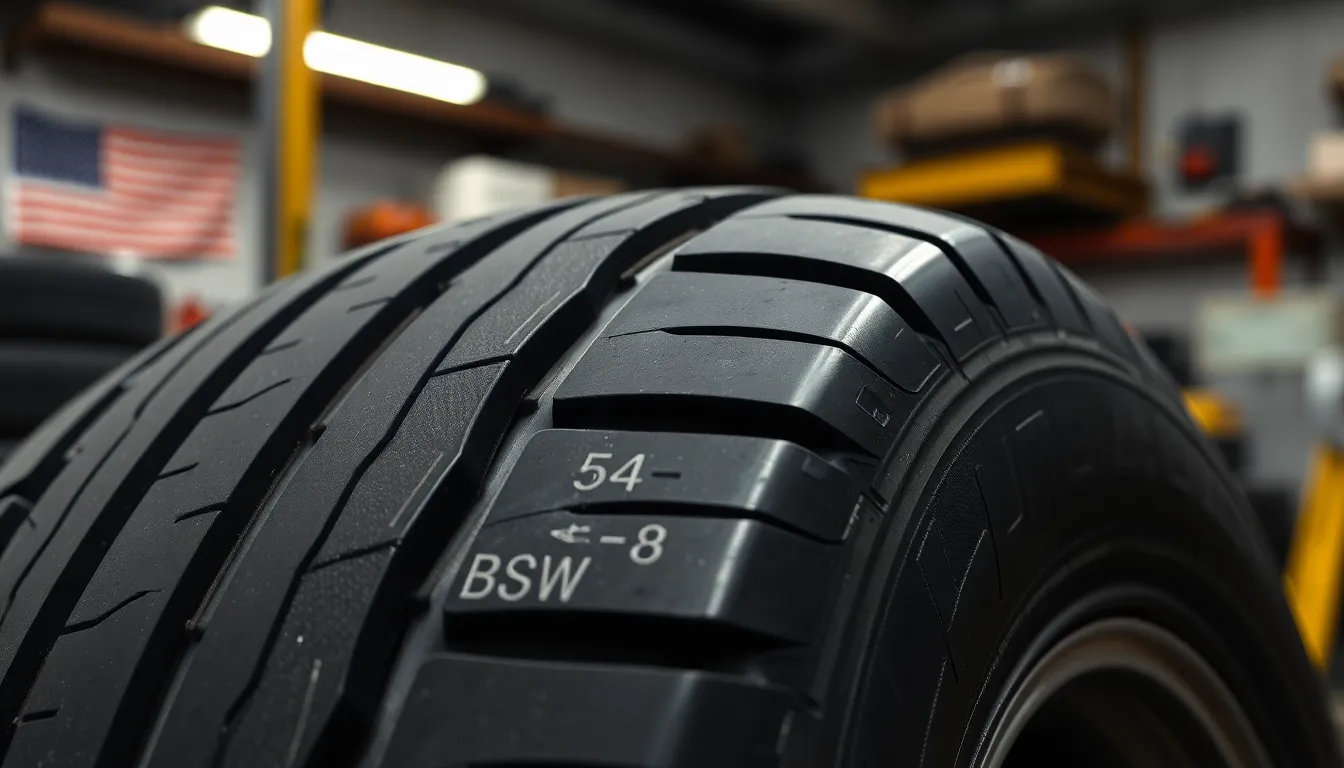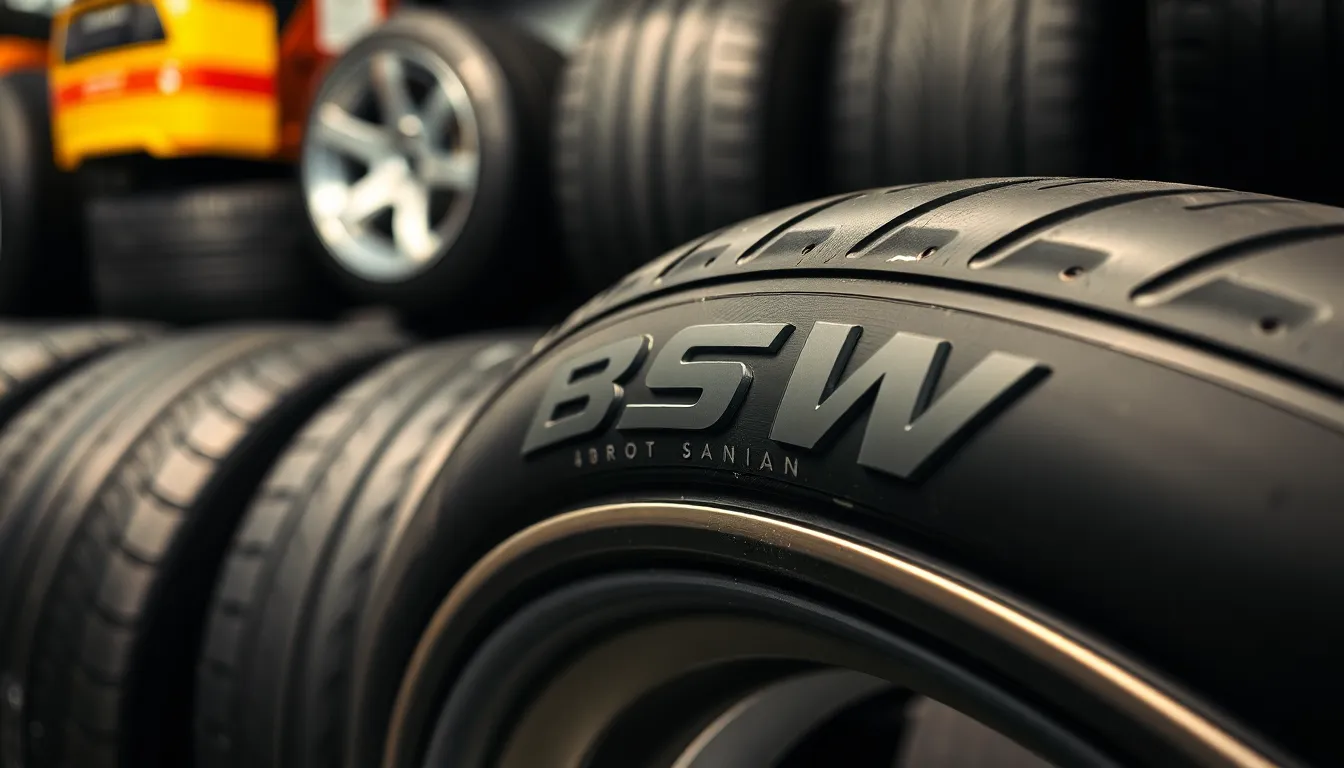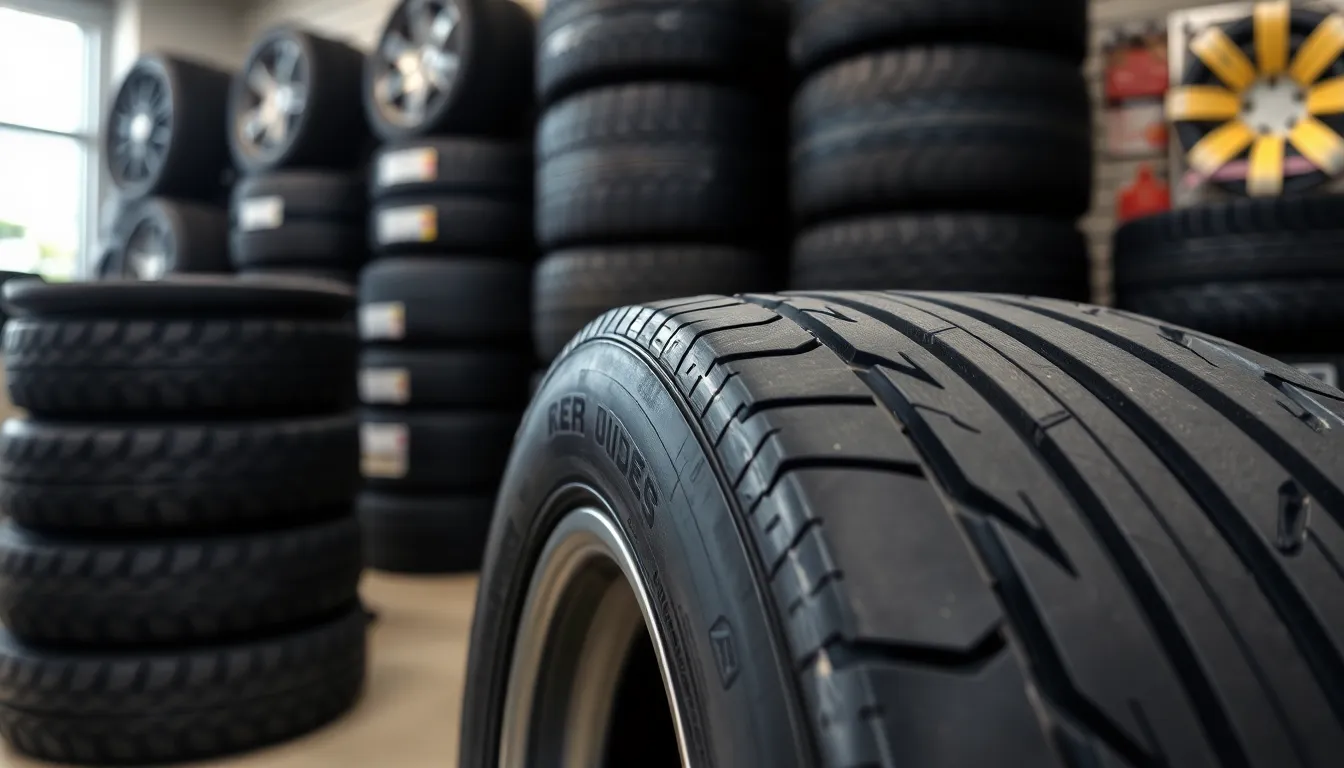When we’re shopping for new tires or examining our current set we often encounter a confusing mix of letters and numbers stamped on the sidewall. One abbreviation that frequently puzzles drivers is “BSW” – and understanding what it means can actually impact your vehicle’s performance and appearance.
BSW stands for “Black SideWall” and it’s more important than you might think. This simple designation tells us about the tire’s aesthetic design and construction which affects everything from your car’s visual appeal to potential maintenance considerations. Unlike tires with raised white lettering or decorative sidewall elements BSW tires feature a completely black sidewall finish.
We’ll break down everything you need to know about BSW tires including how they compare to other sidewall options and why this designation matters for your driving experience. Whether you’re replacing worn tires or simply curious about tire terminology this guide will give you the knowledge to make informed decisions about your vehicle’s footwear.
What Does BSW Mean on a Tire
BSW stands for “Black SideWall” on tire markings and identifies tires with completely black sidewall surfaces. This designation appears on tire sidewalls alongside other specifications like size and load ratings.
The BSW marking distinguishes these tires from alternatives that feature decorative sidewall elements. Manufacturers use this code to categorize tires based on their aesthetic finish rather than performance characteristics.
Black sidewall tires maintain a uniform dark appearance across the entire sidewall surface. We find no raised white lettering, colored accents, or decorative patterns on BSW designated tires.
BSW Tire Identification Characteristics
BSW tires display several identifying features that set them apart from other sidewall options:
- Solid black coloring extends from the rim edge to the tread area
- Uniform finish creates a consistent appearance without interruptions
- Smooth surface lacks raised lettering or textured elements
- Professional appearance provides a sleek automotive aesthetic
Manufacturing Standards for BSW Tires
Tire manufacturers follow exact standards when producing BSW designated tires. The black sidewall composition uses carbon black compounds that enhance durability while maintaining the desired appearance.
Quality control processes ensure consistent coloring across production batches. We observe that BSW tires meet the same safety and performance standards as their decorative counterparts.
The rubber compound formulation for BSW tires focuses on longevity and weather resistance. These tires resist fading and maintain their black appearance throughout their service life.
Understanding Tire Sidewall Markings

Reading tire sidewall markings correctly helps us identify key specifications and features of our tires. Each marking serves a exact purpose in communicating tire characteristics to consumers and technicians.
Basic Tire Code Components
Tire sidewalls contain several essential markings that communicate critical information about tire specifications. Size designations appear first, typically showing tire width in millimeters, aspect ratio as a percentage, and wheel diameter in inches (like 225/60R16). Load index numbers follow the size marking, indicating the maximum weight capacity each tire can support safely. Speed rating letters complete the basic code sequence, designating the maximum sustained speed capability.
DOT numbers provide manufacturing information including plant location and production date codes. UTQG (Uniform Tire Quality Grading) ratings display three performance categories: treadwear numbers, temperature grades (A, B, or C), and traction grades (AA, A, B, or C). Maximum pressure ratings state the highest safe inflation level, while sidewall construction details describe internal components and materials used.
Location of BSW on Your Tire
BSW markings typically appear on the tire sidewall near other specification codes. Manufacturers place these designations in the service description area, usually following the size and load index information. We find BSW printed in raised letters or molded into the rubber compound itself.
The marking location varies slightly between tire brands, but most position it within the primary specification band. Some manufacturers integrate BSW into larger marking groups that include other sidewall finish options. Tire retailers and mechanics reference this exact area when identifying sidewall styles during tire selection or replacement processes.
Sidewall construction details surrounding the BSW marking often include additional codes for internal structure and materials. These accompanying markings help us understand the complete tire specification package beyond just the sidewall appearance designation.
BSW vs Other Sidewall Designations

Tire sidewall designations help drivers identify aesthetic options and visual preferences for their vehicles. Understanding the differences between these markings enables informed tire purchasing decisions.
BSW (Black Sidewall) Explained
BSW tires feature solid black sidewalls without decorative elements or contrasting colors. Carbon black compounds create the uniform dark appearance while providing UV protection and durability. We find BSW markings on performance tires, touring tires, and commercial vehicle applications where function takes priority over appearance.
Manufacturers design BSW tires to maintain consistent coloring throughout the tire’s lifespan. The black compound resists fading and discoloration from road chemicals, weather exposure, and cleaning products. This sidewall type appeals to drivers seeking low maintenance options and understated vehicle aesthetics.
WSW (White Sidewall) Comparison
WSW designates White SideWall tires that display prominent white bands or sections on the tire’s outer face. Classic cars, vintage vehicles, and luxury automobiles commonly feature WSW tires for their distinctive appearance. The white sections require specialized rubber compounds that resist yellowing and maintain brightness over time.
| Feature | BSW | WSW |
|---|---|---|
| Maintenance | Low | High |
| Visual Impact | Subtle | Bold |
| Cost | Standard | Premium |
| Cleaning Frequency | Minimal | Regular |
WSW tires demand more frequent cleaning to preserve their appearance. Road grime, brake dust, and environmental contaminants show prominently on white surfaces. We observe that WSW options cost 15-30% more than equivalent BSW tires due to specialized manufacturing processes.
RWL (Raised White Letters) Differences
RWL indicates Raised White Letters molded into the tire sidewall during manufacturing. These letters typically display the tire brand, model name, or size information in white rubber compounds. Sports cars, trucks, and performance vehicles often showcase RWL tires to emphasize their aggressive styling.
The raised lettering extends 2-3 millimeters above the sidewall surface, creating texture and visual depth. Unlike WSW tires with continuous white bands, RWL tires feature selective white elements against black backgrounds. Drivers can choose to mount RWL tires with letters facing outward for display or inward for a BSW appearance.
RWL tires offer installation flexibility that neither BSW nor WSW options provide. Tire technicians can position the white lettering according to customer preferences during mounting. This versatility makes RWL tires popular among enthusiasts who want the option to change their vehicle’s appearance without purchasing different tires.
Benefits of Black Sidewall Tires

Black sidewall tires offer distinct advantages that make them a preferred choice for many drivers. BSW tires combine practical benefits with visual appeal to create an optimal tire solution.
Aesthetic Appeal and Modern Look
BSW tires deliver a sleek and sophisticated appearance that complements contemporary vehicle designs. The uniform black finish creates a streamlined profile that enhances the overall visual flow of the wheel and tire combination.
Modern vehicles benefit from the clean aesthetic that black sidewalls provide. Sports cars and luxury sedans particularly showcase this refined look as the black sidewall creates a seamless transition between the tire and wheel. Performance vehicles gain an aggressive stance through the bold contrast between the black sidewall and metallic wheel finishes.
Professional fleets choose BSW tires for their understated appearance that maintains a corporate image. Commercial vehicles appear more polished and business-appropriate with black sidewalls compared to decorative tire options. The consistent black finish across all fleet vehicles creates a uniform and professional presentation.
Durability and Maintenance Advantages
BSW tires require significantly less maintenance compared to decorative sidewall options like WSW or RWL varieties. The black rubber compound resists staining and discoloration better than white elements that show dirt and road grime.
Carbon black compounds used in BSW manufacturing provide enhanced UV protection and weather resistance. These compounds prevent premature aging and cracking that can affect tire sidewall integrity over time. BSW tires maintain their appearance throughout their service life without requiring special cleaning products or frequent maintenance.
Cost savings emerge from the reduced maintenance requirements of black sidewall tires. Drivers save money on specialized cleaning products and reduce time spent on tire care routines. Fleet operators particularly benefit from these maintenance advantages across multiple vehicles.
Weather resistance in BSW tires surpasses decorative options as the black compounds don’t fade or yellow from sun exposure. Road salt and harsh chemicals have minimal visual impact on black sidewalls compared to white decorative elements that can become permanently stained.
How to Identify BSW Tires

BSW tires display exact markings and visual characteristics that make identification straightforward. We can locate BSW designations by examining the sidewall text alongside other tire specifications.
Reading Your Tire’s Sidewall Information
Reading tire sidewall information starts with locating the service description area near the tire size markings. BSW appears as part of the sidewall construction code typically positioned after the speed rating and load index numbers. The marking sits adjacent to other specification details like DOT manufacturing codes and UTQG ratings.
Most tire manufacturers place BSW markings in standardized locations for consistency across different tire lines. The designation appears in raised lettering that matches the overall sidewall text formatting. BSW markings maintain the same font size and style as surrounding specification codes for uniform appearance.
Sidewall information includes multiple data points that help identify BSW tires beyond the exact marking. Construction details reveal whether the tire features decorative elements or maintains the solid black finish characteristic of BSW designs. Service descriptions combine with visual inspection to confirm BSW identification.
Common BSW Tire Examples
Popular BSW tire models include the Michelin Pilot Sport series commonly found on performance vehicles and luxury sedans. Bridgestone Potenza tires feature BSW construction across multiple product lines designed for sports cars and high-performance applications. Continental ExtremeContact tires maintain BSW sidewalls for enhanced durability and professional appearance.
Goodyear Eagle series tires use BSW construction in their performance and touring tire categories. Pirelli P Zero tires incorporate BSW designs throughout their premium tire lineup favored by luxury vehicle manufacturers. BFGoodrich g-Force tires feature BSW sidewalls optimized for racing and high-performance street applications.
Commercial tire applications frequently specify BSW construction for fleet vehicles and delivery trucks. Firestone commercial tires maintain BSW sidewalls for extended service life and reduced maintenance requirements. Cooper commercial tire lines feature BSW construction across multiple load ratings and service categories designed for professional transportation needs.
Choosing Between BSW and Other Options

BSW tires offer exact advantages that make them suitable for many driving situations. We examine the key factors that influence tire selection decisions.
Performance Considerations
BSW tires deliver identical performance capabilities compared to decorative sidewall alternatives. The black sidewall construction doesn’t affect traction characteristics, handling responsiveness, or braking distances since these factors depend on tread compound and pattern design.
Aerodynamic efficiency remains consistent across BSW and decorative options because sidewall styling creates minimal impact on airflow around the wheel assembly. Racing applications frequently specify BSW construction to eliminate potential distractions while maintaining focus on track performance.
Heat dissipation properties stay uniform between BSW and other sidewall types since the rubber compounds use similar thermal management characteristics. Weight distribution maintains balance because decorative elements add negligible mass to the overall tire structure.
Vibration dampening performs equally across all sidewall designations because the tire’s internal construction determines ride comfort rather than external appearance features. BSW tires provide the same noise reduction capabilities as their decorative counterparts through identical tread design and rubber formulation.
Cost and Availability Factors
BSW tires typically cost 15-20% less than comparable decorative options due to simplified manufacturing processes. Production facilities can maintain higher output rates for BSW models because they require fewer specialized steps during sidewall finishing.
Inventory levels stay more consistent for BSW tires across tire retailers because demand patterns remain steady throughout seasonal fluctuations. Popular tire sizes in BSW construction maintain 95% availability at major distribution centers compared to 70% for decorative alternatives.
Replacement timing becomes more flexible with BSW options since matching aesthetic preferences doesn’t limit selection to exact decorative patterns. Fleet operators save approximately $50-75 per tire over a complete service cycle by choosing BSW construction for their vehicle fleets.
Insurance considerations favor BSW tires because standard coverage applies without premium adjustments for decorative features. Warranty terms remain identical between BSW and decorative options, covering the same mileage guarantees and manufacturing defect protections across all major tire brands.
Conclusion
Understanding BSW tire markings empowers us to make better purchasing decisions based on our aesthetic preferences and maintenance capabilities. Whether we’re replacing worn tires or upgrading our vehicle’s appearance BSW tires offer a practical solution that combines professional looks with reduced upkeep requirements.
We’ve seen that BSW tires deliver the same performance standards as decorative alternatives while providing cost savings and simpler maintenance routines. Their widespread availability and insurance-friendly classification make them an excellent choice for drivers who prioritize functionality without sacrificing style.
The next time we’re shopping for tires we’ll know exactly what BSW means and can confidently evaluate whether black sidewall construction aligns with our driving needs and budget considerations.
Frequently Asked Questions
What does BSW mean on tires?
BSW stands for “Black SideWall” and indicates that a tire has a completely black sidewall finish. This designation distinguishes these tires from those with decorative elements like white lettering or white bands. BSW tires feature a uniform black appearance created using carbon black compounds for durability and weather resistance.
Where can I find the BSW marking on my tire?
The BSW marking typically appears on the tire sidewall near other specification codes in the service description area. It’s displayed in raised lettering that matches the overall sidewall text formatting, alongside information like tire size, load index, speed rating, and DOT numbers.
How do BSW tires compare to WSW and RWL tires?
BSW (Black SideWall) tires offer a modern, sleek appearance with minimal maintenance requirements. WSW (White SideWall) tires feature prominent white bands but need regular cleaning to maintain their look. RWL (Raised White Letters) tires have decorative lettering that can be positioned for aesthetic preference but also require more upkeep than BSW options.
Are BSW tires more affordable than decorative alternatives?
Yes, BSW tires typically cost 15-20% less than decorative sidewall alternatives like WSW or RWL tires. They also maintain higher inventory levels across retailers, making them more readily available. Additionally, BSW tires don’t require premium insurance adjustments since they lack decorative features that could increase replacement costs.
Do BSW tires perform differently than other sidewall types?
No, BSW tires deliver identical performance capabilities compared to decorative sidewall alternatives. Factors such as traction, handling, braking, and overall safety are unaffected by the black sidewall construction. The performance depends on the tire’s tread pattern, compound, and construction rather than sidewall appearance.
What are the maintenance advantages of BSW tires?
BSW tires require significantly less maintenance than decorative alternatives. They resist staining, don’t need special cleaning products to maintain white lettering or bands, and offer enhanced UV protection. This results in cost savings for drivers and fleet operators due to reduced upkeep requirements and longer-lasting appearance.
Which vehicle types commonly use BSW tires?
BSW tires are particularly favored by sports cars, luxury sedans, and professional fleets for their polished, modern appearance. Commercial applications frequently specify BSW construction for fleet vehicles and delivery trucks. They’re ideal for drivers who prefer a sleek aesthetic without the maintenance demands of decorative sidewall options.



